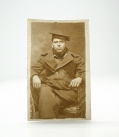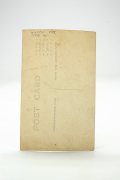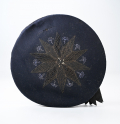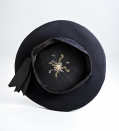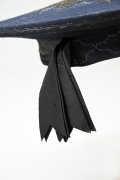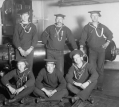site search
online catalog
“REMEMBER THE MAINE!” U.S.S. MAINE DECORATED “GOING ASHORE” NAVY FLAT CAP NTUCKY
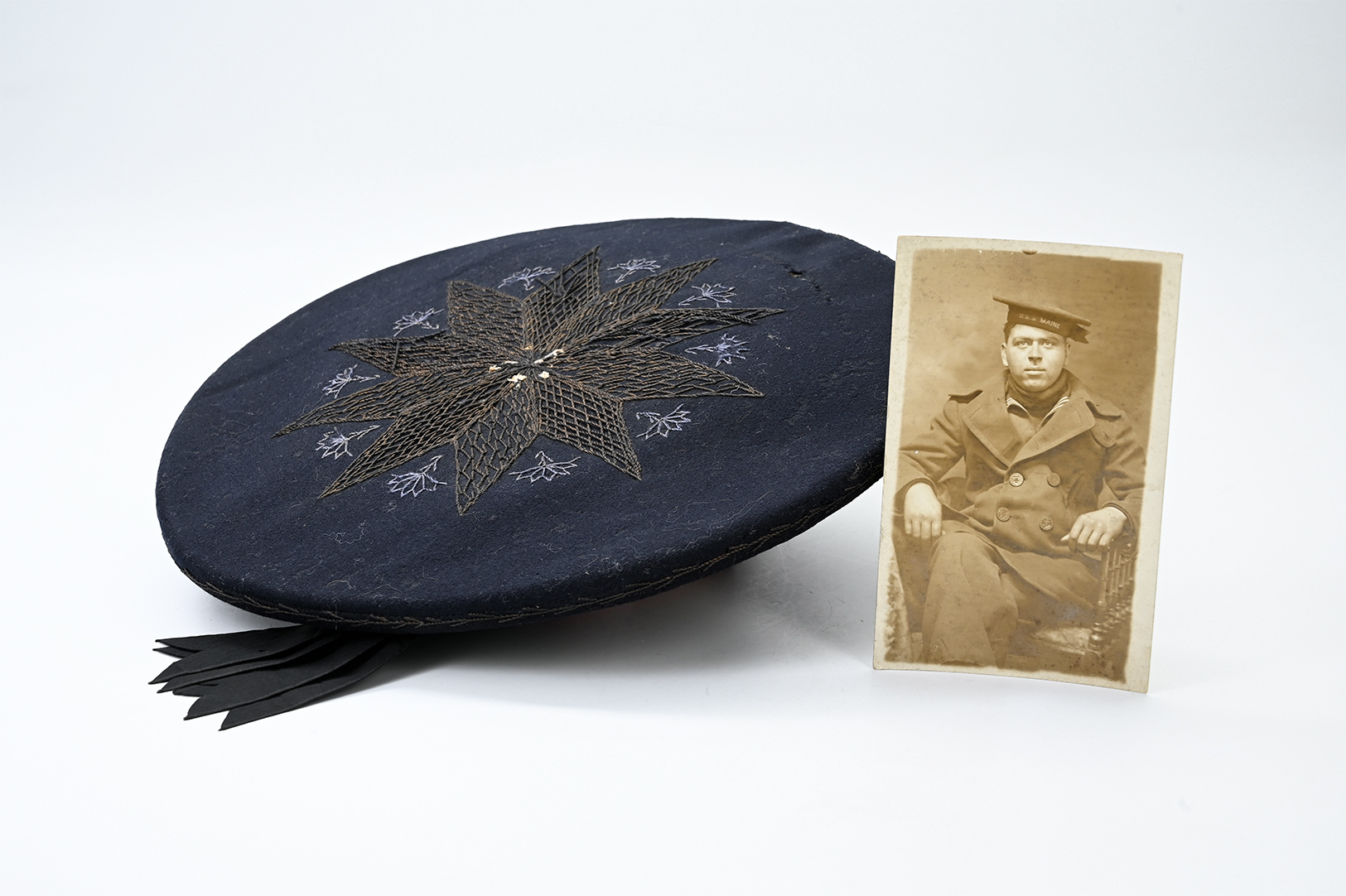
$4,500.00 SOLD
Quantity Available: None
Item Code: 1219-44
There was a long tradition in the U.S. Navy of the men decorating their uniforms with colorful embroidery, both to occupy idle hours on shipboard and in hopes of attracting some attention when on shore. The designs might be concealable and not be displayed during inspections, of course, or the decorated pieces would be reserved entirely for wear on leave. In this case a crewman of the USS Maine decorated an issue navy flat cap in hopes of getting some female attention when he had the chance.
Officially authorized in 1852, the flat hat was not discontinued until 1963, but had fallen out of favor in warmer climates for some time, replaced by the white hat introduced in 1886, though ship and station commanders had the last word on the subject. This shows the very wide top that seems came into fashion in the post-Civil War years as the Navy projected American power on the high seas in competition with Britain and other powers, with the hat shrinking back to its more modest Civil War dimensions around World War One.
The hat shows a regulation gold embroidered black silk tally band reading “U.S.S. MAINE” with forked ends of medium length coming down on the wearer’s left. Hats of this width and with the silk tally band are shown in photographs of the crew on board the ship in 1896. Being worn on duty and on board, those are, of course, otherwise undecorated.
This shows very fine work and attention to detail. The top was embroidered with a large ten-pointed star, each point being the end of an elongated diamond that joins with the others toward the center the cap, the large diamonds differing from their neighbors by slightly different patterns of thread. Some exposed lighter colored threads at the very center may have secured a central rosette of some sort. In between the points of the large star are light blue stemmed, geometric flowers in the angles, using some of the same diamond shapes. The decoration is not limited to the top, however. The sailor has added a long vine or branch with twigs entirely around the perimeter of the top, just below its edge. Further, he did some very finely worked modifications of the tally band, ending it with a point on the wearer’s right side and doubling it back or removing the forked ends and adding them to those on his left- creating two doubled forked ends that hang down. He then secured the band in place with fine x-stitches all along the top and bottom edges and the point, and also has put in a line of stitching running above and below the ship’s name, effectively framing it and forming a band within the band by imitating tied ribbon ends at each end of the ship’s name. He then used a blue thread to create an open work design running all the way around the back of the cap from the pointed end of the ribbon to the loose forked ends. Unfortunately, he seems to have been interrupted in his work and never completed it.
Construction of ship was authorized in 1886 and started in 1888. It was launched in 1889 and finally commissioned in 1895 and assigned to the North Atlantic Squadron, operating out of Norfolk and along the east coast and in the Caribbean. The long design and construction period left the ship already outdated for some of its tasks, but armed with 10-inch and 6-inch guns as well as smaller pieces and torpedoes. The ship entered the harbor at Havana, Cuba, in January 1898 in theory to protect U.S. interests while the Cubans fought the Spanish for independence. Three weeks later, on the night of February 15, the ship was destroyed when the powder magazines blew up, killing roughly 261 of the 355 officers and men aboard, Navy and Marines. Initial reports and many later studies attributed the explosion to a spontaneous fire in the ship’s coal bunkers. Accusations or insinuations of a Spanish mine, however, combined with growing U.S. interest in intervening in the Cuban War of Independence, led to war little more than two months later.
The condition of the cap is very good. The thread of the open work star on the top has oxidized slightly from what likely black to a faint green and some of the threads are loose, but the design is intact. There are just a couple of moth bites. The blue design around the base of the cap was broadly outlined, but not completed, but being along the back of the cap, is not really noticeable. Similarly, a few lighter color threads at top center may simply have shifted color and been to anchor the star design, or to hold a small circle or rosette at the center, but they are not obtrusive.
Accompanying this hat is a real photo postcard added by a collector showing a crewmember of the later (1901) USS Maine, wearing the narrower style cap, but still proudly showing a USS Maine tally band. The card is unaddressed and unmailed. An old pen inscription on the back reads “Happy Orr / Clyde NY.” On the remote chance that he was one of the earlier crew who survived the 1898 explosion and served on the later ship we checked the roster of crewmen in Weems’ “Fate of the Maine,” but found no Orr among them. [sr] [ph:m]
~~~~~~~~~~~~~~~~~~~~~~~~~~~~~~~~~~~
THIS ITEM, AS WITH ALL OTHER ITEMS AVAILABLE ON OUR WEB SITE,
MAY BE PURCHASED THROUGH OUR LAYAWAY PROGRAM.
CLICK HERE FOR OUR POLICIES AND TERMS.
THANK YOU!
Inquire About “REMEMBER THE MAINE!” U.S.S. MAINE DECORATED “GOING ASHORE” NAVY FLAT CAP NTUCKY
For inquiries, please email us at [email protected]
Most Popular
Historical Firearms Stolen From The National Civil War Museum In Harrisburg, Pa »
Theft From Gravesite Of Gen. John Reynolds »
Selection Of Unframed Prints By Don Troiani »
Fine Condition Brass Infantry Bugle Insignia »
British Imported, Confederate Used Bayonet »
Scarce New Model 1865 Sharps Still In Percussion Near Factory New »
featured item
CIVIL WAR COMMERCIAL FORAGE CAP WITH MAINE BUTTONS AND ASSOCIATED INSIGNIA
Commercial caps were simply those purchased privately rather the issued by the government. They might more or less closely follow contract patterns with the purchaser able to suit his taste and wallet, though an enlisted man, seeking something nicer… (1052-139). Learn More »
site search
Upcoming Events
May 16 - 18: N-SSA Spring Nationals, Fort Shenandoah, Winchester, VA Learn More »




